Residential New Construction
Whether you’re building a new home, remodeling an existing house or adding a garage, we have the tools and guidance to support your project. This is your one-stop shop for meeting your electric service needs.
Interested in rebates and energy efficiency? Check out our Residential New Construction Energy Efficiency Rebate Program and see how decisions made at the beginning of your build can deliver energy savings for years after construction is complete.
Questions? We’re here to help you every step of the way. We look forward to working with you!
1-877-535-0394 or 218-355-2644
Email: newconstruction@mnpower.com
Relevant Documents:
Construction Request
Your Residential Electric Service
The information contained in this guide will help you understand the steps involved in establishing electric service. We outlined each step in the process, including both an overview and detailed information. A well-prepared application, a well-prepared site and good communication with Minnesota Power are the best ways to keep your project on track.
Step 1. Application and Planning
Your Role: Minnesota Power will be happy to serve your energy needs if your property is within Minnesota Power's service territory. To determine if Minnesota Power will be your electric service provider, please visit www.mnpower.com, call the New Construction Center at 1-877-535-0394 or 218-355-2644 or e-mail us at: newconstruction@mnpower.com.
Next, complete the Application for Service (form 6034D). You may fill out the online version or the PDF version of the application. If you choose the PDF version, please mail, fax or e-mail both your application and your site plan to:
Mail:
Minnesota Power
Attn: New Construction Center
3215 W Arrowhead Rd
Duluth, MN 55811
Fax: 218-720-2795
Email: newconstruction@mnpower.com
Step 2. Confirmation
Our Role: After we receive your completed application, a Minnesota Power representative will contact you. They will discuss your electric service needs and if needed, set up an appointment for a site visit. A Minnesota Power representative will provide site requirements and cost estimates after the site visit.
Step 3.
Your Role: Complete all of the requirements to prepare the site for service installation.
We ask that the customer prepares the site as follows:
- Mark all property corners with stakes, with “Property Corner” labeled on the stake.
- Identify approximate location where customer’s electric service panel will be installed.
- Grade and landscape within six inches of final grade where the Minnesota Power representative has determined facilities will be installed.
-
Maintain a service path clear of obstructions from the Minnesota Power electric facilities to the meter location.
- A minimum 10-foot-wide path for underground installation
- A minimum 30-foot-wide path for overhead installation.
- Locate and mark privately-owned underground facilities with stakes, spray paint or flags.
- In the event that we need to cross your driveway with Minnesota Power underground electric facilities, we ask that a four-inch Schedule 40 conduit be installed, extended 10 feet beyond each side of the driveway.
- If you, the customer, will require any excavation at your site, please visit the Gopher State One Call Web site: www.gopherstateonecall.org, or dial 811 to have underground, utility-owned facilities marked.
Location of Underground Facilities
It is important for Minnesota Power to know the location of all existing and planned facilities, structures or other potential obstructions to ensure a clear path for your electric service lines. Be sure to clearly mark these facilities as noted on your submitted site plan.
Utility-owned Facilities
Minnesota Power will contact Gopher State One Call to have underground, utility-owned facilities located and marked on your property, for example: water, gas, electric, sewer, telephone and cable. Gopher State One Call requires each party to obtain their own One Call ticket for excavation.
Privately-owned Facilities
The customer is responsible for the location and marking of privately-owned underground facilities, for example: water, gas, electric, sewer, telephone and cable.
Minnesota Power (and/or its contractors) will not be held responsible for damage to private underground facilities that have not been properly identified and marked.
For further information on companies that provide private locating, please contact Minnesota Power at 218-720-2757.
Electrical Inspections
Minnesota Power requires a copy of the Request for Electrical Inspection or verification from the local electrical inspector prior to energizing any service.
Outside the city of Duluth
Within the state of Minnesota jurisdictional area, the electrical contractor will be responsible for filing a Request for Electrical Inspection with the state of Minnesota and for providing a copy to Minnesota Power.
For a list of licensed and bonded electrical contactors, go to: http://www.dli.mn.gov/, or call 651-284-5026.
Submit the form to the state along with the appropriate fees. If you have any questions regarding the fees, please contact the state of Minnesota at 651-284-5026. Keep a copy of the form for you own records.
Send a copy of the form to:
Mail:
Minnesota Power
Attn: New Construction Center
3215 W Arrowhead Rd
Duluth, MN 55811
Fax: 218-720-2795
Email: inspections@mnpower.com
Inside the city of Duluth
Within the city of Duluth, it is the responsibility of the electrical contractor to contact the city of Duluth for the electrical inspection. Once the inspection has been completed, the city electrical inspector will notify Minnesota Power.
If you have any questions regarding electrical codes, please contact your electrical contractor or the local inspector.
Fees
Payment for line extension and/or temporary electric service, if required, must be received by a Minnesota Power representative prior to scheduling your installation. Minnesota Power does not offer any financing options. Full payment can be made in the form of check, money order, purchase order, credit card (Visa, MasterCard, Discover) or debit card. A 4% transaction fee will be added to all credit card payments.
Mail:
Minnesota Power
Attn: New Construction Center
PO Box 77065
Minneapolis, MN 55480-7765
Step 4. Scheduling and Installation
Our Role: Minnesota Power will make every effort to meet your requested completion date. The amount of time it takes to complete the installation depends on a variety of factors. Once all requirements are met, the work will be scheduled.
Your Role: During this step of the process, make sure your site remains ready for service. Inform your builder to keep the path where the new service will be installed clear of obstructions. Please be sure to keep us informed of any design or scheduling changes.
Please provide the name of the person whom we can speak with about the details and coordination of your project.
Step 5. Billing
Our Role: Billing will begin as soon as the electric meter is installed. The bill will include both a monthly minimum service charge and an energy usage charge.
Your Role: Once the new home is occupied, the new occupant/homeowner is responsible for contacting us to have the electric bill transferred into their name. This is only necessary if the account was previously in the name of the builder/general contractor.
Costs to Provide Power
Basic Costs
The Minnesota Power representatives will design the electrical service extension, determine the locations of facilities and estimate extension costs. Estimates depend upon location of existing distribution facilities, location of customer’s buildings on the property and the design decision of overhead or underground facilities.
Extensions
Single phase extensions less than 1,000 feet under normal construction circumstances are based upon a unit cost per linear foot (subject to change upon annual review). Contact New Construction Center for current cost per foot.
New Construction Center
www.mnpower.com
1-877-535-0394 or 218-355-2644
newconstruction@mnpower.com
Extensions over 1,000 feet are not based upon a cost per linear foot. Your Minnesota Power representative will calculate the cost of the extension based upon labor and materials.
Additional Costs
If conditions exist that impede the installation of your new service line, additional construction charges will be added to the standard unit cost per foot. These conditions, such as surface or subsurface impediments, may include, but are not limited to, frost, rock, subsurface structures, wetlands and underwater installations. Please be sure to keep us informed of any design or scheduling changes. Keep in mind these changes may result in additional costs and/or delays.
Temporary Service Installation
Temporary service is defined in Minnesota Power’s Extension Rules as “service to a customer whose use of that service, in the company’s judgment, may be less than five years' duration”.
A customer may choose to have a temporary service during the construction phase of the project. The customer provides the temporary service structure including, but not limited to, proper timber construction with sufficient bracing and approved meter socket. Temporary services should not be located closer than 10 feet from the Minnesota Power facilities (examples: pole, pad-mounted transformer).
Cover-up
The following are requirements of OSHA regulation sections 1926.416(a)(1) and 1926.550(a)(15).
1926.416(a)(1): Protection of employees. No employer shall permit an employee to work in such proximity to any part of an electric power circuit that the employee could contact the electric power circuit in the course of work, unless the employee is protected against electric shock by de-energizing the circuit and grounding it or by guarding it effectively by insulation or other means. (This requires a minimum clearance of 10 feet for lines rated 50 kV or less).
1926.550(a)(15): Cranes. Except where electrical distribution and transmission lines have been de-energized and visibly grounded at point of work or where insulating barriers, not a part of or an attachment to the equipment or machinery, have been erected to prevent physical contact with the lines, equipment or machines shall be operated proximate to power lines only in accordance with the following (i) For lines rated 50 kV or below, minimum clearance between the lines and any part of the crane or load shall be 10 feet.
It is the responsibility of the contractor to contact Minnesota Power to provide cover-up.
Contact the central dispatch area for scheduling and fee schedule at 218-720-2757.
Right-of-way
Easements, Permits or Licenses
Minnesota Power’s Extension Rules require customers to provide “satisfactory right-of-way necessary for the construction, operation and maintenance of the extension (including any tree-trimming rights) both for the purpose of providing access to the extension on the customer’s premises and for continuing the extension to other customers, has been furnished without expense to the company” (Extension Rules, Section 8, Paragraph 3).
Providing satisfactory “right-of-way” requires that we have a general understanding of the term to mean “ a strip of land used by a utility company and others AND the right to pass over the land of another. ”
-
Right-of-way involves “land,” both public land and private land.
- Public land—involving streets, roads, highways, forest lands, wetlands, lakes, rivers, streams and trails—will (almost always) require either a permit or a license.
- Private land—involving commercial and rural property, including railroad and mining property—can require an easement and, on occasion, require a license.
-
Right-of-way involves (primarily) three forms of legal documentation:
- Easement—a written document giving one party (grantee) the right and privilege to use the land of another (grantor) for a special purpose.
- Permit—a written document giving one party (permittee) permission and personal privilege to do some act on the land or right-of-way of another (permitter), usually for an unspecified duration of time (no term) and for a fee.
- License—a written document giving one party (licensee) permission and personal privilege to do some act on the land or right-of-way of another (licensor), usually for a specified duration of time (term) and for a fee.
Your Minnesota Power representative will help determine if the line extension will affect public or private land and identify the legal document that will be necessary in order for Minnesota Power to extend electric service to your business. All expenses or costs involving right-of-way (acquisition of easements, permits or license) will be paid by the customer.
Utility Easement Restrictions
Minnesota Power suggests that easements remain clear of any obstructions that will make it difficult to maintain or replace the existing facilities. Keeping utility easements clear helps utility companies perform routine maintenance, construct improvement projects and repair utility lines during emergencies. Minnesota Power will make an effort to limit damage to landscaping; all damages to landscaping located within the boundaries of the utility easement are the responsibility of the landowner.
Residential Programs
Dual Fuel
The Dual Fuel interruptible service is an interruptible rate with two options effective October 1st, 2023:
- Dual Fuel Standard: Discounted rate with limited interruptions.
- Dual Fuel Plus: Lowest discounted rate with longer and more frequent interruptions.
More information on active Dual Fuel rates is available here.
When electric heat is connected to the Dual Fuel Service, customers must ensure they have adequate backup heat or storage heat to remain comfortable during interruptions.
Fixed Off-Peak
Storage Heating Rate
The Fixed Off-Peak rate is designed around the ability to store energy for space and water heating. During off-peak hours from 10 p.m. to 6 a.m., when the cost of electricity and system demand is less, storage heating equipment turns on and stores the energy needed for the balance of the day. A storage system can consist of thermal storage room units, a central storage furnace, a central hot water system or slab heat. Water heating on the storage rate generally requires a minimum of one 80-gallon electric water heater or two 52-gallon electric water heaters. Larger combinations may be necessary depending on hot water demand. Electricity to energize the heating equipment is on only between 10 p.m. and 6 a.m. This system is also known as controlled access or “ETS” (electric thermal storage).
Conditions:
To qualify for the Fixed Off-Peak rate, you must have sufficient storage capacity to meet your building’s space or water heating needs. The owner will receive a Fixed Off-Peak Agreement and the tax-exempt card after the meter is installed (all heating fuels in the state of Minnesota are tax-exempt).
How to Participate:
Call Minnesota Power at 218-355-2843, for more information on the Fixed Off-Peak program.
New Construction Energy Efficiency Rebate Program
Homeowners and builders can qualify for more than $4,000 in incentives when building a new home!
Minnesota Power’s New Construction Energy Efficiency Rebate Program seeks to promote building practices and technologies that enhance the energy-efficiency, comfort, health and durability of the new construction market in and around Minnesota Power’s service territory. Think of your home as an energy-efficient system that can be optimized to deliver the outcomes you desire (comfort, durability, energy performance, operational efficiency, cost control). The New Construction Energy Efficiency Rebate Program encourages energy-efficiency upgrades and ensures quality building by conducting on-site inspections and completing home performance tests.
Minimum Requirements to Participate:
- Home will be heated primarily with electric heat.
- Installing an Energy/Heat Recovery Ventilator (ERV/HRV) with a minimum sensible recovery efficiency (SRE) of 60%.
Free Program Offers:
- A plan review prior to construction
- On-site inspection during construction to help identify energy efficiency opportunities
- A final home performance inspection that includes a building air-tightness (blower door) test and infrared thermal scan (if temperature difference allows)
- Access to rebates
Visit our website at www.mnpower.com/RNC or contact us at 218-355-2843 for rebate details.
Installation of Minnesota Power Electric Service
Your site will be reviewed to determine the nearest power source and meter location options for the installation of your new electric service. Unless customer voltage needs cannot be met, Minnesota Power distribution facilities will be located as far as 300 feet from your electrical service panel. Minnesota Power facilities will be located in a truck-accessible location to ensure ongoing access for maintenance. Design and installation of Minnesota Power facilities will be determined by Minnesota Power personnel and will be constructed according to Minnesota Power Engineering Standards and the National Electrical Safety Code (NESC).
Overhead Installation
Lot Line Metering—Company Standard
With lot line metering, company-provided meter enclosure on a company owned pole will be located at the lot line or in close proximity of Minnesota Power facilities. Your contractor can connect customer owned underground cable to the meter enclosure to provide you temporary construction power. Minnesota Power’s lot line metering enclosures have a capacity of 200 amperes and provide connecting lugs for three sets of conductors; however, they do not provide space for individual breakers. You and/or your electrical contractor will need to arrange for an outdoor weatherproof load center, GFCI breakers or GFCI outlets and grounding for temporary service. Minnesota Power’s point of service is at the bus work on the load side of the breaker. The customer and/or electrical contractor is responsible for sizing, purchasing, installing and maintaining material from Minnesota Power’s meter enclosure to the customer’s electrical service equipment.
Meter Loop*
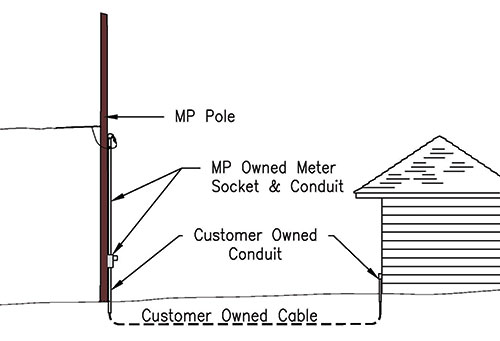
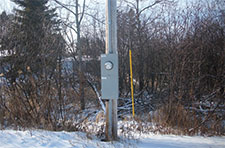
Meter enclosure on power pole
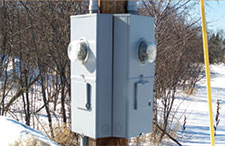
Meter enclosures on power pole
*Minnesota Power does not allow any customer-owned equipment to be attached to MP-owned meter sockets, meter pedestals or poles. The customer is allowed to connect loads inside the socket by use of factory knockouts and up to the number of factory supplied connections available in the socket (typically 3 but sometimes 2). Modifications of entries into the socket outside of factory supplied knock out locations is not permitted. Use of add-a-lugs on the meter jaw assembly is expressly prohibited.
If your Minnesota Power representative has determined that lot line metering is not appropriate for your installation, the following options may be applicable.
Overhead Installation— Where Lot Line Metering is not Applicable
Overhead installation is the overhead electrical power line from Minnesota Power’s utility pole to your meter location. The customer is responsible for sizing, purchasing, installing and maintaining the meter enclosure, riser pipe, weatherhead, and Point of Attachment (POA).
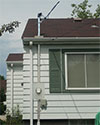
Overhead service drop

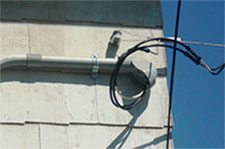
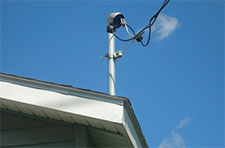
Types of Point of Attachment (POA)
When multiple conduit risers or service masts are installed to support a single electric entrance, it is the customer’s responsibility to provide the connector that ties the customer’s conductors (wires) together and allows for a single point of connection to Minnesota Power’s conductors.
| Clearance Table | |
| Over street, alley, public roadway, parking lot, drive-in, commercial, industrial and farm areas | 16’ minimum |
| Over residential garage driveways | 15’ 6” minimum |
| **Over areas accessible to pedestrians | 12’ minimum |
Note: Interpretation of the NESC allows for specific clearance exceptions to this table. ** Only to be used under Minnesota Power Engineering approval.
Minnesota Power’s connectors at the Point of Attachment (POA) shall meet National Electrical Safety Code (NESC) minimum clearance. All customer owned equipment shall meet any applicable National Electric Code (NEC) requirements. A Minnesota Power representative will work with your electrical contractor to meet all national clearance requirements and applicable local and state codes.
Underground Installation
Lot Line Metering—Company Standard
With lot line metering, company-provided meter enclosure on a pedestal will be located at the lot line or in close proximity of Minnesota Power facilities. Your contractor can connect to the meter enclosure to provide you temporary construction power. Minnesota Power’s lot line metering enclosures have a capacity of 200 amperes and provide connecting lugs for three sets of conductors; however, they do not provide space for individual breakers. You and/or your electrical contractor will need to arrange for an outdoor weatherproof load center, GFCI breakers or GFCI outlets and grounding for temporary service. Minnesota Power’s point of service is at the bus work on the load side of the breaker. The customer and/or electrical contractor is responsible for sizing, purchasing, installing and maintaining material from Minnesota Power’s meter enclosure to the customer’s electrical service equipment.
Meter Pedestal*
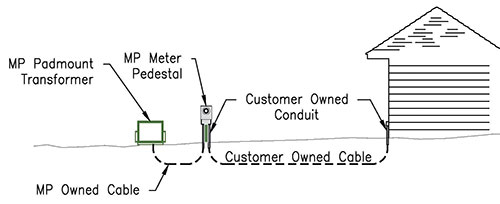
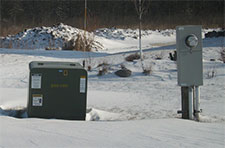
Pad-mounted transformer with lot line meter pedestal
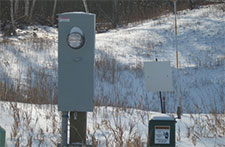
Secondary pedestal with meter pedestal
*Minnesota Power does not allow any customer-owned equipment to be attached to MP-owned meter sockets, meter pedestals or poles. The customer is allowed to connect loads inside the socket by use of factory knockouts and up to the number of factory supplied connections available in the socket (typically 3 but sometimes 2). Modifications of entries into the socket outside of factory supplied knock out locations is not permitted. Use of add-a-lugs on the meter jaw assembly is expressly prohibited. The use of connectors such as polaris lugs inside a Minnesota Power owned socket is also prohibited.
Underground Installation Where Lot Line Metering is not Applicable
The customer is responsible for sizing, purchasing, installing and maintaining the underground conductor (cable), meter enclosure, conduit, weatherhead (if applicable), and all other associated material needed from customer’s electric service equipment to Minnesota Power’s point of service.
Connecting to Ground-mounted Facilities
When connecting private underground service cable to Minnesota Power’s ground-mounted facilities, the customer will provide, own and maintain the cable.
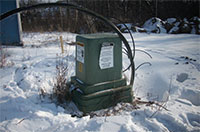
Secondary pedestal with conductors
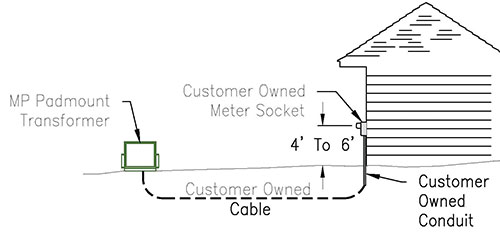
The customer shall dig and install private underground service cable to within one foot of any side of the secondary pedestals or the front right side (the front is the side where the lock is located) of a pad-mounted transformer, leaving a minimum of six feet of cable above ground for connection purposes. In conjunction with customer, Minnesota Power personnel will dig the remaining trench length, dig under the transformer or secondary pedestal and connect the cable to the transformer or secondary pedestal.
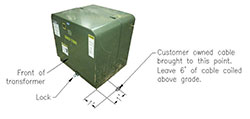
Front side of pad-mounted transformer with lock
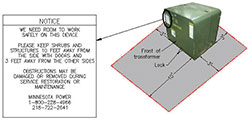
Meter Requirements
Bypass Metering Requirements
If Lot Line Metering is Not Used

In order to minimize power interruptions during meter replacement or calibration, and to ensure safety of Minnesota Power employees, all residential, customer-owned, self-contained meter sockets must have a jaw-clamping, lever-type bypass. No device is allowed between the socket and the meter.
Horn-type bypasses are not acceptable bypasses.
A lever bypass meter socket is required for all new installations. It is also required when any of the following is being done:
- Overhead to underground conversions
- Replacement of underground cable from meter
- Weatherhead/mast replacement
- Replacement of service panel with equal or greater amperage rating
- Generator installation (backup generator, solar, wind, battery storage, etc.)
Self Contained Metering
200-Amp Single-Phase 3-Wire—4 or 5 terminal, 200-amp, jaw-clamping, lever-operated bypass, weatherproof, ringless, screwless cover, 5th jaw at nine o’clock position, hub opening for overhead, closure plate or plain top for underground.
320-Amp Single-Phase 3-Wire—4 terminal, 320-amp, jaw-clamping, lever-operated bypass, weatherproof, ringless, screwless cover, hub opening for overhead, closure plate or plain top for underground Anti-inversion clips in the upper right jaw are not allowed.
200 Amp 2 Position Single Phase 3 Wire—4 terminal, weatherproof, 200-amp jaw-clamping, lever-operated bypass per position, ringless, screwless cover, hub opening for overhead, closure plate or plain top for underground.
Approved Meter Sockets—List of Manufacturers
Landis and Gyr, Milbank, T&B, Anchor, Durham, Siemens, Square D, Cutler Hammer and Midwest Electric are examples of UL approved metering equipment providers.
Sample Part Numbers
Millbank U-4801-XL-5T9
Siemens Drawing 48804, PN 48804-02NU
Sample Meter Spec
*Note: Metering services greater than 320A and in excess of 240V require instrument-rated metering equipment.
Meter Location
Outdoor metering is required for all installations unless prior approval is given.
- For outdoor installations, the center line of all meters shall be between four and six feet from the finished grade.
- A minimum three feet of unobstructed working space, as measured from the surface on which it is mounted, should be maintained in front of the meter, and a minimum of 12 inches of unobstructed space should be maintained on all sides of the meter cover. Ample space shall be provided for all meters, metering equipment and other apparatus so that they can be safely read, inspected and tested.
Please call Minnesota Power’s Meter Department at 1-800-228-4966 for questions regarding sockets.
*Note: Your local or state electrical code may have additional requirements.
Temporary Metering Requirements
Minnesota Power requires bypass meter sockets for temporary service installations.
Apartment Process and Metering
Updated Content
These standards will be applicable anytime the metering is not located outside on new construction or when major changes are made to a service that would deem it new construction. Any exceptions from these standards must be approved by meter engineering.
- A meter room is a dedicated room on the ground floor directly accessible from the outside. Securing means will be by Minnesota Power lock or a customer lock with a key housed in a lock box accessible to Minnesota Power representatives.
- Meter rooms will not be used for storage.
- Meter rooms may contain communications and/or CATV.
- Meter rooms may not contain water or gas services or equipment.
- The meter room will be illuminated and ventilated directly to the outside.
- Personnel doors will open outward and be equipped with panic bars, pressure plates or similar devices that operate under simple pressure.
Process:
Customers will be required to take separate temporary power for construction of the apartment building. The apartment building house panel and apartments/units will not be energized until all meter sockets are properly labeled and identified, along with any electrical inspection requirements. Partial energization of a building will not be allowed. Meter sockets must be labeled as set forth in Meter labeling standards below.
Meter Labeling Standards:
- Labels must be permanent or permanently affixed (i.e., magic marker or tape is not permanent).
- Label must be legible.
- Label must be visible.
- Label must not be on socket cover.
Contact your assigned Design Representative when all sockets are labeled and you would like your permanent service energized.
Outdoor and Area Lighting
Leasing outdoor lighting from Minnesota Power is quick, easy, and economical. You can select an area light, which gives you a wide circle, or a floodlight to direct the illumination in one direction. Minnesota Power will install, replace and maintain your outdoor and area lighting service. The customer will agree to rent the area lights and necessary poles for a minimum of six months.
Contact Minnesota Power at 1-877-535-0394 or 218-355-2644 for information on outdoor and area lighting services.
Options for Lighting
LED
- 7,000 lumen area light (48 watts or less) LED48W
- 10,000 lumen area light (71 watts or less) LED71W
- 24,000 lumen area floodlight (184 watts or less) LED184W
- 46,800 lumen area floodlight (320 watts or less) LED320W
Depending on the customer's needs, there may be a pole rental fee associated with the installation.
Scheduling
A well-prepared application and site, along with good communication with your Minnesota Power representative, is the best way to keep your project on track. The amount of time it takes to complete the installation depends on a variety of factors. The work order will not be released for scheduling until all required items on the checklist have been received. A minimum of two weeks should be expected before the work will begin. Weather, changing site conditions, pending service work already scheduled, extent of work to bring supply lines to property, restrictions such as permits and right-of-way, and other unforeseen circumstances all may delay progress.
Scheduling questions can be directed to your local Minnesota Power representative and/or Minnesota Power central dispatching area at 218-720-2757.
Distributed Generation
Minnesota Power customers planning to install customer-owned generation on their home or business must first read and understand Minnesota Power’s interconnection guidelines. The specific Interconnection Guideline that applies will depend on the type, size, and operating mode of the generation that is proposed. Customers installing distributed generation systems of 10 MW or less must follow the “State of Minnesota Interconnection Process for Distributed Generation Systems” and the “State of Minnesota Distributed Generation Interconnection Requirements.” These documents can be found on the Distributed Generation website: www.mnpower.com/CustomerService/DistributedGeneration.
Upon receiving an interconnection application, Minnesota Power will conduct a Preliminary Review of the service and the proposed system including an Engineering Study, if applicable. Because each installation is unique, interconnection applications will not be approved prior to a Preliminary Review. During this review, a Minnesota Power representative will assess the current service and identify site specific conditions that may affect the installation. All equipment from the utility transformer to the customer’s service equipment will be evaluated and the customer will be notified if upgrades are required.
Conditions:
The standards and requirements for installing distributed generation along with the available rates will vary based on the type, size, and operating mode of the system that is being installed.
How to Participate:
For more information, contact Minnesota Power’s Renewable Programs at 218-355-3720 or visit www.mnpower.com/Environment/Solar.
Application Forms
Instructions for Completing the Application Form
Below are detailed instructions for completing each section of the application. If you have questions after reading this information, please call the New Construction Center at 1-877-535-0394 or 218-355-2644.
Contact and Billing Information
Please provide the name of the person that we can speak with about the details and coordination of your project Also provide the name and/or names of the person that will be billed for the kilowatt hour usage once the electric meter has been installed.
Project Location
Please provide the address (i.e., 123 Main St, Anytown, MN) of your site as listed on your building permit. If you do not have an address, contact the county where your building site will be located.
County Website addresses:
- Beltrami - http://www.co.beltrami.mn.us
- Cass - http://www.co.cass.mn.us
- Carlton - http://www.co.carlton.mn.us
- Crow Wing - http://crowwing.us
- Hubbard - http://www.co.hubbard.mn.us
- Itasca - http://www.co.itasca.mn.us
- Koochiching - http://www.co.koochiching.mn.us
- Lake - http://www.co.lake.mn.us
- Otter Tail - http://www.co.otter-tail.mn.us
- Pine - http://www.co.pine.mn.us
- St. Louis - http://www.co.st-louis.mn.us
- Stearns - http://www.co.stearns.mn.us
- Todd - http://www.co.todd.mn.us
- Wadena - http://www.co.wadena.mn.us
US Postal Service: https://www.usps.com
If you have difficulty in receiving an address, please provide us the nearest neighboring address and a legal description, including a parcel number.
Project Timeline
Minnesota Power will make every effort to meet your project deadline. Please provide us the date that you need the electric power installed. An actual date is required in this field (“ASAP” or “Immediately” are not considered valid dates). Remember that we are usually scheduled out two to four weeks and that it takes time to process your request.
Service Specifications
This is the most crucial portion of your request. For Minnesota Power to design the installation of facilities, we need to know your electric load requirements. Please have your electrical engineer or electrician provide you this information. If we do not have the correct information, additional time, labor and costs could become an issue.
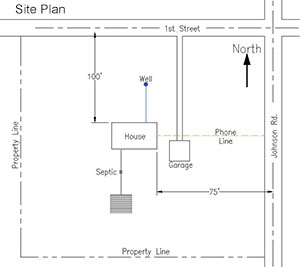
Authorization
A signature (or an electronic signature) is required to move forward with your project.
Certified Map or Site Plan
Please provide a certified survey map. If a survey map is not available, please provide a detailed sketch showing property lines, existing structures, proposed structures, any private underground facilities (i.e., well, septic, private underground power to other structures, etc.), setbacks, distance of all structures from property lines, overall dimensions of all structures, and proposed work.
- Residential Construction Request (Form 6034D)
Call Numbers
New Construction Center
- Toll Free Area Wide: 1-877-535-0394
- Duluth Area: 218-355-2644
- Outside Duluth Area: 218-355-2644
24-hour Customer Service and Questions About Your Bill
- Toll Free Area Wide: 1-800-228-4966
- Duluth Area: 218-722-2625
Lights Out
- 24-hour Automated Outage Reporting: 1-800-30-POWER (1-800-307-6937)
Automated Meter Reading Reporting
- 1-888-30-METER (1-888-306-3837)
Shareholder Services
- Toll Free Area Wide: 1-800-535-3056
- Duluth Area: 218-723-3974
TTY/TDD
- Hearing Impaired Customer Service: 1-800-367-3180
ALLETE
- 218-279-5000


